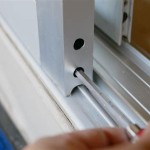How to Remove Sliding Patio Doors
Removing a sliding patio door is a task that can be undertaken by homeowners with some DIY experience. However, it generally requires careful planning, the right tools, and a systematic approach to avoid injury or damage to the door frame or surrounding structures. This article provides a detailed guide on how to safely and effectively remove sliding patio doors. Before starting any work, assess the door’s weight and condition and, if necessary, enlist the help of another person to prevent accidents.
Preliminary preparations are crucial before beginning the physical removal process. These steps ensure a smooth and safe operation, minimizing potential setbacks and complications. The initial stage involves gathering necessary tools and supplies, followed by a thorough examination of the door and its surrounding structure. This examination helps identify any potential issues that might impede the removal process. Finally, preparing the work area safeguards the surrounding environment and provides a safe and unobstructed space to maneuver.
First and foremost, gather the required tools and materials. A well-equipped toolkit significantly streamlines the removal process. Essential items include a drill with various bits, a pry bar, a putty knife or utility knife, safety glasses, work gloves, a screwdriver set (both flathead and Phillips head), a hammer, shims, a measuring tape, and possibly a reciprocating saw (if the door frame is significantly damaged or needs modification). Having the right tools readily available prevents unnecessary delays and ensures the job can be completed efficiently and safely.
Next, carefully examine the sliding patio door and its surrounding frame. This inspection helps in understanding the door's construction and how it's fastened to the structure. Look for any visible screws, nails, or adhesive used to secure the door. Pay close attention to the tracks, rollers, and locking mechanisms, as these components might need specific attention during removal. Identifying any rust, corrosion, or damage is essential as it will impact the required approach. Understanding the door assembly is key to a smooth and safe removal process.
Preparing the work area is another critical step. Clear the area around the door both inside and outside to provide ample working space. Cover the floor with drop cloths or protective sheeting to prevent scratches or damage from falling debris or tools. Ensure adequate lighting to see clearly and work safely. If working outdoors, check the weather forecast and postpone the project if inclement weather is expected. A well-prepped work area minimizes the risk of accidents and damage, creating a safer and more efficient working environment.
Disengaging the Door From the Frame
The next stage involves detaching the sliding door from its frame. This typically involves loosening or removing any fasteners, adjusting the rollers, and carefully lifting the door out of its track. Each step requires precision and caution to avoid damage to the door, frame, or surrounding structures. This process is often the most delicate part of the removal.
Begin by removing any screws or fasteners securing the door to the frame. Examine the top, bottom, and sides of the door for screws, nails, or other fasteners. Use the correct screwdriver or drill bit to remove them. If fasteners are painted over, carefully score the paint around the head with a utility knife to prevent tearing the paint when removing them. Keep track of any removed fasteners by placing them in a labeled container to avoid losing them. Removing all visible fasteners is essential before attempting to lift the door.
Adjust the door’s rollers, if adjustable. Most sliding patio doors have rollers at the bottom that allow for height adjustment. Locate the adjustment screws, typically found on the door's bottom edge. Use a screwdriver to adjust the rollers, lowering the door to create more clearance between the door and the top track. This adjustment reduces friction and makes it easier to lift the door out of the frame. If the rollers are stuck or corroded, apply a penetrating lubricant to loosen them.
Carefully lift the sliding door up and out of the track. With the fasteners removed and the rollers adjusted, lift the door upwards and tilt the bottom out of the track. This maneuver requires controlled force and may necessitate assistance from another person, particularly for heavy doors. Once the bottom is clear, carefully pull the door away from the frame, ensuring it doesn’t catch on any remaining parts. If the door is stuck, gently pry it loose with a pry bar, being careful not to damage the frame or door. Support the door as it is removed to prevent it from falling. Once free, carefully set the door aside in a safe location.
Removing the Stationary Door and Frame Components
After removing the sliding door, the next task is removing the stationary door (if there is one) and any remaining frame components. This might involve unscrewing or prying off fixed panels, removing the track, and disassembling any remaining hardware. The process varies depending on the door's design and construction. Careful observation and a methodical approach are crucial.
If the patio door includes a stationary panel, carefully detach it from the frame. This non-operable panel is usually secured with screws or adhesive. Locate the screws and remove them using the appropriate screwdriver. If the panel is glued in place, use a putty knife or utility knife to carefully score around the edges, breaking the adhesive bond. Gently pry the panel away from the frame using a pry bar. Exercise caution to avoid splintering the wood or damaging the surrounding wall. Once detached, safely set the stationary panel aside.
Remove the door track and any other remaining frame components. The track is typically attached with screws, nails, or adhesive. Use a screwdriver, drill, or pry bar to remove these fasteners. If the track is glued in place, use a utility knife to score along the edges and then gently pry it off. Be mindful of any wires or cables that might be running through the frame, and disconnect them before removing the track. Dispose of the old track and components properly, following local recycling guidelines where applicable.
Inspect the exposed wall after removing the frame components. Check for any signs of water damage, mold, or rot. If any damage is found, address it immediately to prevent further problems. Replace any damaged wood or insulation. Cleaning the area and preparing it for the installation of a new door or window is important. Patch any holes or cracks in the wall to create a smooth and even surface. This preparation ensures a clean and secure installation for its replacement.
Safety Precautions and Considerations
Safety should always be a top priority during any DIY project, particularly when dealing with heavy objects like sliding patio doors. Adhering to basic safety guidelines minimizes the risk of injury and ensures a smooth and uneventful process. This section outlines essential safety precautions and considerations to keep in mind during the removal process.
Always wear safety glasses and work gloves. Safety glasses protect eyes from flying debris, such as splinters or fragments of glass. Work gloves provide a better grip and protect hands from cuts, scrapes, and splinters. These simple protective measures significantly reduce the risk of common DIY injuries. Properly fitted personal protective equipment (PPE) is crucial for safety.
Get help when lifting heavy doors or frame components. Sliding patio doors can be surprisingly heavy, and attempting to lift them alone can lead to back strain or other injuries. Enlist the help of another person to share the load and maintain control. Communicate clearly and coordinate movements to avoid dropping the door or causing other accidents. Teamwork ensures a safer and more efficient removal process.
Be aware of potential hazards. Look out for electrical wiring that might be running through the door frame. If wiring is present, turn off the power to the circuit before proceeding. Be careful when using sharp tools like utility knives and pry bars. Keep the work area clear of obstacles and ensure adequate lighting. By identifying and mitigating potential hazards, accidents can be avoided. Maintaining focus and awareness is key to a safe project.
Proper disposal of the old door and frame components is also important. Check local regulations for proper disposal methods. Some components, like glass and metal, may be recyclable. Dispose of any hazardous materials, such as lead paint or asbestos, according to local guidelines. Responsible disposal protects the environment and prevents potential health hazards.

How To Remove Sliding Glass Door Diy Guide From Action

How To Remove A Sliding Glass Door Burano Doors

How To Remove Sliding Patio Doors Youtube

How To Replace A Sliding Glass Door With French Doors

How To Remove Install A Patio Sliding Door

How To Remove A Sliding Screen Door 9 Steps With Pictures

How To Remove Sliding Glass Door Diy Guide From Action

How To Replace A Patio Door Diy Family Handyman

How Can I Remove My Pella Sliding Door From The Frame Swisco Com
How To Replace A Sliding Patio Door








